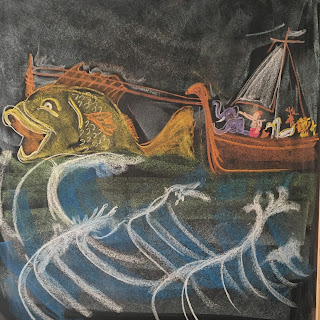*this post contains affiliate links*
One of the reasons I love Teacher's Lounge so much is that the printables are as beautiful as they are educational. The graphics are so striking that your child will instantly be attracted and eager to dive into the explorations. You can see in the pictures below how much Sean (shown at ages 4 & 5) enjoys the lessons. I paired a beginning letter sound worksheet on ocean animals with a metal easel and magnetic letters to create one of his favorite activities. How nice that all I need to do is print and use a piece of washi tape to set it up! In the other pictures below Sean is working on math skills with a size comparison activity from the Outer Space set of lessons. He loves their many cut and paste pages!
Another exceptional thing about The Teacher's Lounge is that my youngest is certainly not the only child to use these lessons. I have found many instances where the lesson sets cover topics that my fourth and sixth grader are studying. In the examples below we used many of the lessons in the Flowers unit for fifth grade botany. We found the anatomy of a plant from TL to be the best version amongst the many resources we had for our botany block. We are looking forward to using lessons from TL Geology for one of our sixth grade science blocks. It's great to be able to print and laminate a play dough mat for a preschooler and a superior science resource for an advanced grade school student at the same time!
Lately, we've stopped waiting for our lesson blocks to coincide with the Teacher's Lounge offerings - they're just too good not to use right away! Instead we've been using a lesson for our Science Friday afternoon and incorporating literacy into our days as well. We recently used the awesome lesson on animals to explore what pupil shape and eye placement mean to predators and prey. We checked a few of the suggested books out of the library and had a great time learning about animal eyes as a family. My three boys, ages 5-11, were all engaged. Sean was cutting, sorting, pasting and talking about the animals while his older brothers were busy categorizing the animals by taking cues from pupil shapes. I love it when we can learn as a family and I don't need to scour the internet for hours to find something appropriate for everyone!
The Teacher's Lounge offers lots of support for your development as a teacher. The Professional Development pages offer lessons for you on how to teach and include printables for planning, observing and assessing. The galleries are also a great resource to see pictures of the lessons in action.
Just click any of the links on this page to sign up for The Teacher's Lounge. If you are interested in checking out the Teacher's Lounge, enrollment is open on Wednesday, September 26th and will close on October 24th. Just click any of the links on this page to sign up for The Teacher's Lounge. The Teacher's Lounge adds new topics twice a month and as a member you have access to all previous topics (there are dozens - each topic includes many lessons). Topics range from Poetry and Writer's Notebook to Architecture, Mapping and Geology. Here is one last example of some printouts from the Sea Life topic:
I will be offering one lucky reader a FREE ONE YEAR SUBSCRIPTION on Instagram next week when enrollment opens. Be sure to visit @lyons_academy to enter the giveaway!






















































